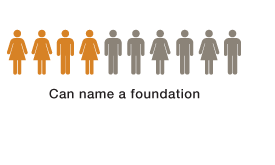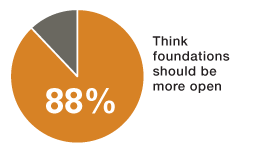How do influential Americans see foundations? How can foundations reach influential Americans? Here are six aspects of the challenge.
1. Who Do We Need To Reach?
 We’re encouraging foundations to focus more communications muscle on reaching influential Americans. From state legislators to grassroots advocates, this group includes government, business, and news media decisionmakers and the engaged citizens who influence them. They’re a broader target than the usual suspects of grantees, grantseekers and donors but narrower than that longtime darling of collective awareness efforts, the general public.
We’re encouraging foundations to focus more communications muscle on reaching influential Americans. From state legislators to grassroots advocates, this group includes government, business, and news media decisionmakers and the engaged citizens who influence them. They’re a broader target than the usual suspects of grantees, grantseekers and donors but narrower than that longtime darling of collective awareness efforts, the general public.
2. An Awareness Deficit

PAI research suggests that philanthropy faces an awareness deficit among the most engaged citizens. Only four in ten can name a foundation. Only one in ten can identify a foundation’s impact on an issue they care about. We’d expect those on the frontlines of community improvement to know something about foundations that exist to support their work. Most do not.
3. How Did We Get Here?
 Asked what drives the awareness deficit, many philanthropy leaders say “let’s look in the mirror.” Among the obstacles they cite, four stand out: the belief that “the work will speak for itself,” stories that focus on dollars out the door rather than impact achieved, a lack of relationships with decisionmakers, and failing to engage trustees and others as foundation ambassadors.
Asked what drives the awareness deficit, many philanthropy leaders say “let’s look in the mirror.” Among the obstacles they cite, four stand out: the belief that “the work will speak for itself,” stories that focus on dollars out the door rather than impact achieved, a lack of relationships with decisionmakers, and failing to engage trustees and others as foundation ambassadors.
4. Three Opportunities
 The bad news might be the awareness deficit, but there’s good news, too. Surveys commissioned by PAI suggest that engaged citizens have high expectations for foundations—expectations that many consider foundations well-positioned to meet. They feel foundations are important to their communities. And if they’re provided some kind of experience with foundations, they show higher appraisal of their work.
The bad news might be the awareness deficit, but there’s good news, too. Surveys commissioned by PAI suggest that engaged citizens have high expectations for foundations—expectations that many consider foundations well-positioned to meet. They feel foundations are important to their communities. And if they’re provided some kind of experience with foundations, they show higher appraisal of their work.
5. What’s At Stake?
 The bad news might be the awareness deficit, but there’s good news, too. Surveys commissioned by PAI suggest that engaged citizens have high expectations for foundations—expectations that many consider foundations well-positioned to meet. They feel foundations are important to their communities. And if they’re provided some kind of experience with foundations, they show higher appraisal of their work.
The bad news might be the awareness deficit, but there’s good news, too. Surveys commissioned by PAI suggest that engaged citizens have high expectations for foundations—expectations that many consider foundations well-positioned to meet. They feel foundations are important to their communities. And if they’re provided some kind of experience with foundations, they show higher appraisal of their work.
6. A Path Forward
 How can foundation and philanthropy association leaders close the awareness deficit and build support among influential Americans? Our conversations with many of these leaders point to six areas of communications and outreach that need improvement: greater urgency about the need, better targeting of influentials, sharper messages about value, stronger stories of impact, more ambassadors mobilized, and better connections made.
How can foundation and philanthropy association leaders close the awareness deficit and build support among influential Americans? Our conversations with many of these leaders point to six areas of communications and outreach that need improvement: greater urgency about the need, better targeting of influentials, sharper messages about value, stronger stories of impact, more ambassadors mobilized, and better connections made.
